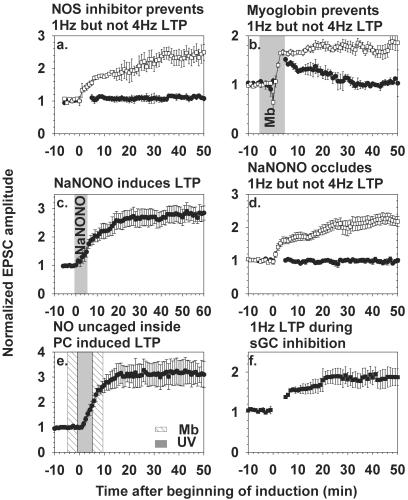Figure 2.
NO is necessary for, mimics, and occludes 1 Hz but not 4 Hz LTP, without requiring sGC. (a) Application of the NO synthase inhibitor Nω-nitro-l-arginine (100 μM) starting at least 1 h before recording and continuing throughout the experiment prevents 1 Hz (●, n = 6) but not 4 Hz LTP (□, n = 7). (b) Oxymyoglobin (10 μM) as an NO scavenger was added to the perfusion solution for 10 min (shaded region) starting 5 min before LTP induction. The 1-Hz stimulation protocol gave only transient potentiation (●, n = 3), whereas 4 Hz LTP was normal (□, n = 4). (c) Exposure of the slice to the NO donor NaNONO (10 μM) for 5 min (shaded region) causes substantial LTP (n = 5). (d) NO-induced LTP occludes 1 Hz but not 4 Hz LTP. Slices were preincubated with 10 μM NaNONO for 5 min then left for 30–60 min to allow the NO enhancement to reach a stable maximum. We delayed beginning the whole-cell recording until after this period, because prolonged intracellular dialysis would itself prevent further initiation of synaptic modulation. Subsequent 1 Hz LTP (●, n = 5) was prevented, whereas 4 Hz LTP (□, n = 6) was still inducible. (e) Uncaged NO induces LTP. Either N,N′-dicarboxymethyl-N,N′-dinitroso-p-phenylenediamine, 2Na (200 μM) or CNO-4 (200 μM) was introduced through the patch pipette and photolyzed with 300 UV flashes of 5-ms duration at 1 Hz, applied during the gray shaded zone. In the experiments shown (n = 4), 10 μM oxymyoglobin was present in the extracellular superfusate during the crosshatched zone. Similar results (not shown) were obtained without oxymyoglobin (n = 4). In all experiments except f, the pipette solution contained 5 mM BAPTA. (f) Inhibition of guanylyl cyclase with ODQ (1 μM, n = 4), present throughout the experiment, did not prevent 1 Hz LTP induction.

